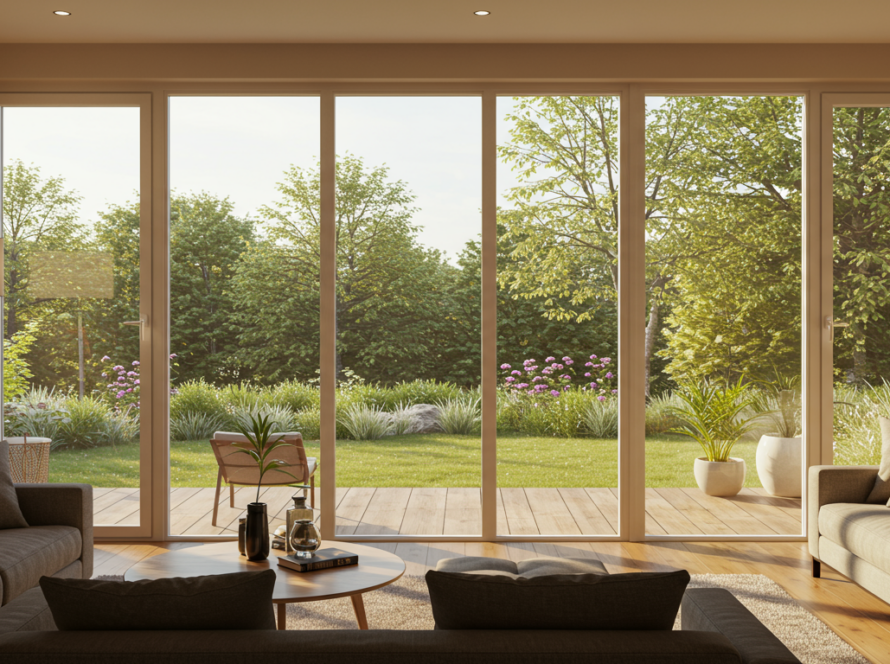When upgrading your windows, the debate between double-pane vs. triple-pane windows is one of the most important decisions to make. Both options offer insulation and energy savings, but which one fits your needs, budget, and climate best?
Double-pane windows are the most common choice for their cost-effectiveness and energy efficiency, while triple-pane windows go a step further with superior insulation and soundproofing. This guide breaks down the differences, benefits, and key factors to help you make the right choice for your home.
TLDR – Quick Guide
- Double-pane windows: Cost-effective and energy-efficient, ideal for mild climates.
- Triple-pane windows: Enhanced insulation and noise reduction, perfect for extreme climates or noisy areas.
- Energy savings: Triple-pane windows can reduce energy loss by an additional 20%-30% compared to double-pane.
- Cost difference: Triple-pane windows are 15%-25% more expensive but may qualify for energy rebates.
- Climate matters: Choose double-pane for moderate regions and triple-pane for harsh weather or high noise pollution.
Detailed Breakdown
1. What Are Double-Pane Windows?
Double-pane windows feature two layers of glass with an insulating layer of gas, such as argon or krypton, sandwiched between them. This design minimizes heat transfer and helps maintain a stable indoor temperature.
Benefits:
- Cost-effective insulation.
- Widely available and easy to install.
- Reduces energy bills by up to 25%.
2. What Are Triple-Pane Windows?
Triple-pane windows add a third layer of glass and an additional insulating gas chamber. This design enhances insulation and soundproofing, making it a premium choice for extreme weather conditions or noisy environments.
Benefits:
- Superior thermal performance—reduces energy loss by up to 30% more than double-pane.
- Significant noise reduction.
- Prevents condensation and improves indoor comfort.
3. Key Differences: Double-Pane vs. Triple-Pane Windows
| Feature | Double-Pane Windows | Triple-Pane Windows |
| Energy Efficiency | Good, reduces energy loss by ~25% | Excellent, reduces energy loss by ~35%-50% |
| Cost | Lower initial cost | 15%-25% more expensive upfront |
| Soundproofing | Decent noise reduction | Superior noise reduction |
| Weight | Lighter, easier installation | Heavier, requires sturdy frames |
| Best for | Mild to moderate climates | Extreme climates or noisy areas |
4. How to Choose Between Double-Pane and Triple-Pane Windows
Consider Your Climate
- Mild climates: Double-pane windows typically provide sufficient insulation.
- Harsh climates: Triple-pane windows offer better protection from extreme heat or cold.
Assess Noise Levels
- Quiet neighborhoods: Double-pane windows are usually adequate.
- High-traffic areas: Triple-pane windows are worth the investment for better soundproofing.
Think About Your Budget
- Double-pane windows are more affordable upfront and offer great energy savings.
- Triple-pane windows, while pricier, can save more on long-term energy costs and may qualify for tax credits or rebates.
5. Long-Term Energy Savings
Upgrading to energy-efficient windows pays off over time:
- Double-pane: Save up to $125 annually in energy costs for an average home.
- Triple-pane: Save up to $200 annually, with even greater savings in extreme climates.
Check for ENERGY STAR-rated windows to maximize savings and qualify for rebates.
Key Takeaways
- Double-pane windows: Great for most homes, offering cost-effective insulation and good energy savings.
- Triple-pane windows: Ideal for extreme climates or noise-prone areas, providing superior performance but at a higher upfront cost.
- Consider your needs: Climate, budget, and noise levels are key factors in deciding between double- and triple-pane windows.
- Energy efficiency matters: Both options significantly reduce energy waste, lowering your bills and carbon footprint.
- Rebates available: Check for incentives to offset the cost of upgrading to energy-efficient windows.
Whether you choose double- or triple-pane windows, both are excellent investments in comfort, energy efficiency, and the long-term value of your home.
FAQs
1. What’s the main difference between double-pane and triple-pane windows?
Double-pane windows have two glass layers with insulating gas in between, while triple-pane windows have an additional layer and gas chamber for improved insulation and soundproofing.
2. Are triple-pane windows worth the extra cost?
In extreme climates or noisy areas, yes. They provide better energy savings, noise reduction, and comfort, which can offset the higher upfront cost over time.
3. Can double-pane windows handle cold winters?
Yes, double-pane windows are effective in most climates, including areas with cold winters. However, triple-pane windows perform better in harsh or prolonged cold conditions.
4. Do triple-pane windows reduce noise significantly?
Yes. The additional pane and gas chamber in triple-pane windows provide superior soundproofing, making them ideal for homes near busy roads or airports.
5. How much more expensive are triple-pane windows?
Triple-pane windows typically cost 15%-25% more than double-pane options. However, they often qualify for energy efficiency rebates or tax credits, which can help offset the expense.


